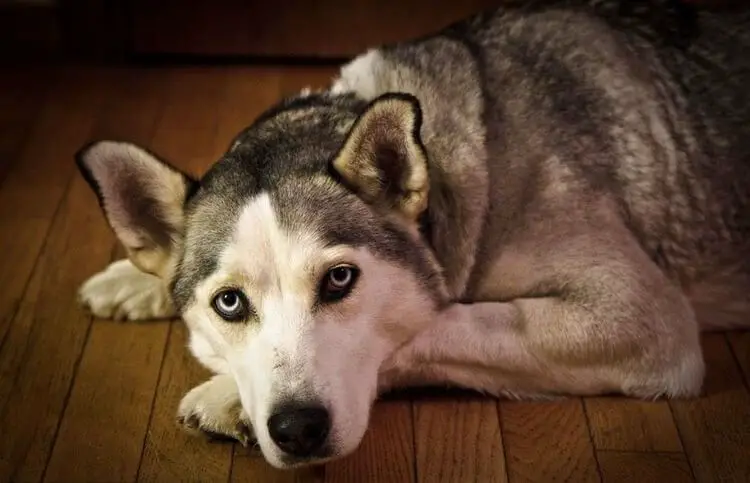Dogs also lose mobility with age. One possible cause is spondylosis of the spine. Ossification leads to a “stiff back”. We give tips about spondylosis in dogs.
What is Dog Spondylosis?
Having a stiffer spine in old age – this is the core problem in spondylosis, in simplified terms. More precisely, it concerns changes in the vertebral bodies. Bony outgrowths develop on these and adjoin the neighboring vertebral bodies.
This can then lead to ossified “bridges” – two neighboring vertebrae grow together. At the same time, the elasticity of the dog’s spine decreases – it swings less with movements.
Spondylarthrosis is when the vertebral joints above the spine also ossify.
Spondylosis – Which Dogs Are Affected?

Two risk factors, in particular, are decisive: size and age. Large breed dogs in particular tend to ossify when they are older.
There are also certain breeds that are more prone to spondylosis – these include boxers and other Molossian-type dogs. They have weaker supporting connective tissue. Overloading or injuries can also trigger spondylosis.
Dog Spondylosis: Gait Pattern and Symptoms
Fortunately, spondylosis occurs in many four-legged friends with no or only mild symptoms. That is why spondylosis in dogs is often an incidental finding: the vet discovers it on an X-ray that he made based on any symptoms that occurred independently. However, some dogs show the following symptoms:
- Pain and difficulty getting up;
- Pain when touching the back;
- Problems jumping or climbing stairs;
- Problems turning/turning tightly;
- Limp;
- Rare: incontinence;
- Rare: paralysis.
Symptoms of spondylosis in dogs can come on in intermittent phases. Although severe symptoms are rare, the condition can cause other changes. Because of the stiffer spine, the intervertebral discs are under greater pressure.
Spondylosis can therefore promote herniated discs in dogs. You can prevent this with therapy and appropriate behavior in everyday life.
Spondylosis Therapy for Dogs
There is no cure for spondylosis – but many dogs can live with it largely symptom-free. Watch your animal companion closely so that you can take countermeasures in good time if there is pain.
Spondylosis therapy is about relieving pain and promoting the dog’s mobility. At the same time, it prevents further complications such as a herniated disc. The following therapeutic approaches are possible:
Painkillers and medication for spondylosis
Painkillers for dogs that are anti-inflammatory at the same time are often used for spondylosis. They can significantly increase the quality of life. That is why regular administration is important if the veterinarian has prescribed it.
Cortisone injections injected directly into the affected areas of the body can also provide rapid relief.
Movement and exercises for spondylosis
If you rest, you rust – regular exercise is good for dogs with “stiff backs”. It is important not to overwhelm your four-legged friend. Agility, ball games or lots of stairs are not suitable.
Extensive hikes or motivating sniffing and search games, on the other hand, do. In an acute phase of pain, your four-legged friend may not want to walk – respect this and move him after consulting the veterinarian.
Physiotherapy for Spondylosis
Physiotherapy is ideal for dogs with ossified vertebrae. Aquatherapy is particularly helpful for dogs. Because here the vortices are relieved in the movement. Balance exercises on a balance board can also help, depending on the symptoms.
With passive physiotherapy, your four-legged friend can relax – for example with a massage or during red light therapy.
Food Supplement for Dogs with Spondylosis
The classic home remedies for the dog’s skeleton include green-lipped mussel powder and rosehip powder. If the dog is already in pain, it is a possible supplement, but not a substitute for medication prescribed by the veterinarian.
This also applies to homeopathic remedies for spondylosis in dogs. Coordinate alternative treatment methods with your veterinarian.
If Necessary: Weight Loss
As with all skeletal diseases, the following applies: too many pounds are harmful! If your four-legged friend is too fat, healthy weight loss is the order of the day at the latest after a spondylosis diagnosis.
Acupuncture for Spondylosis
Acupuncture can help clear blockages in the dog’s body. Although its effectiveness has not been scientifically proven, many dog owners report improvements in spondylosis. Acupuncture is said to activate the release of pain-relieving substances in the brain. One variant is gold acupuncture, which some veterinarians offer.
How Can I Prevent Spondylosis in Dogs?
To prevent skeletal diseases in dogs, avoid overweight and one-sided stress on your four-legged friend. Anyone interested in a boxer should buy puppies from a reputable breeder. This tests the parent animals for spondylosis.
You should only buy a dog there if the spine is flawless (“spondylosis grade O” or “spondylosis grade I” at the age of two). Only from “spondylosis grade 3” is there a breeding ban.
Tips for Dogs with Spondylosis
- An orthopedic dog bed provides relief for the back;
- Stop immediately if conspecifics want to ride;
- A dog ramp replaces jumps in the trunk, a small dog stair jumps on the sofa;
- Carrying aids can relieve large dogs of inevitable stairs;
- Pay attention to the slimline of your four-legged friend;
- A dog coat keeps your back warm in winter;
- Dry off the dog well after rain or swimming;
- Avoid hard bowel movements through an adapted diet.

